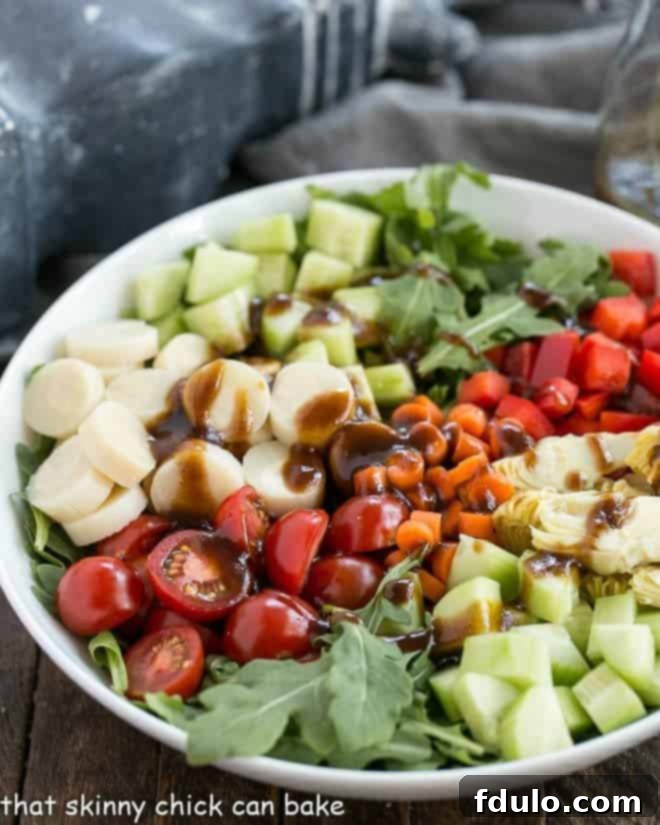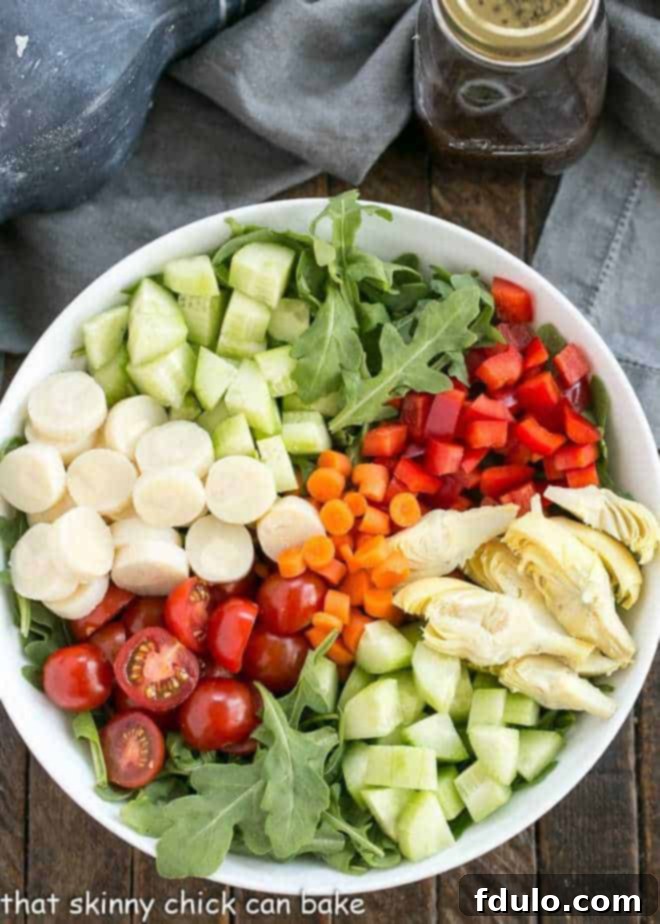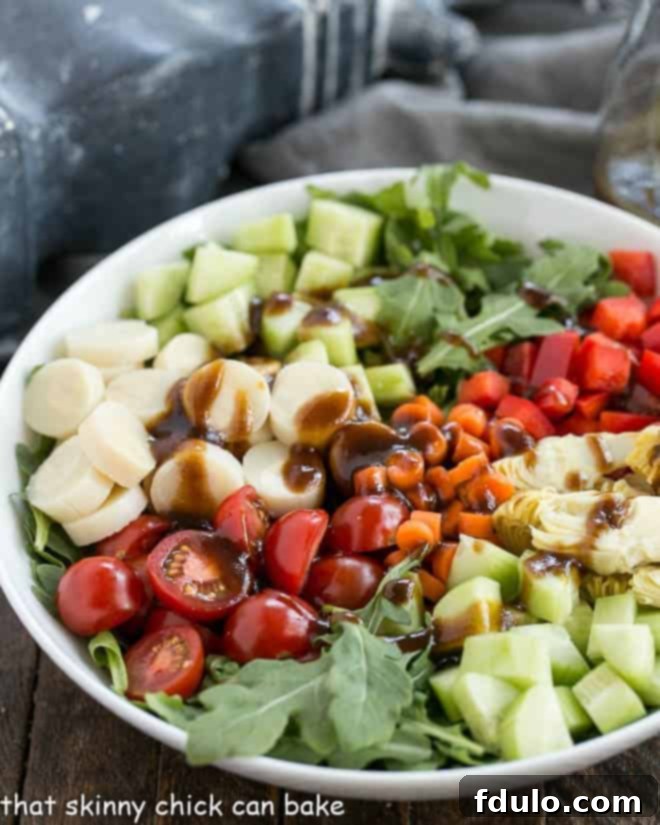While store-bought dressings often offer convenience, there’s an undeniable satisfaction and superior flavor that comes from a homemade vinaigrette. For years, this delightful Easy Balsamic Vinaigrette has been my steadfast companion for countless salads, transforming simple greens into a culinary delight. It’s not just a dressing; it’s a revelation of fresh, vibrant taste that elevates any meal.

The Irresistible Charm of Homemade Balsamic Vinaigrette
I’ve previously featured this exquisite yet simple balsamic vinaigrette in several of my salad recipes, but its incredible versatility and ease of preparation truly merit its own dedicated spotlight. The beauty of this recipe lies in its simplicity and the accessibility of its ingredients. Chances are, most of what you need is already a staple in your pantry, making it effortlessly quick to whip up this classic salad dressing whenever the craving strikes.
Opting for a homemade dressing like this Easy Balsamic Vinaigrette is a game-changer for several reasons. Beyond the undeniable freshness, it gives you complete control over the ingredients, allowing you to avoid artificial preservatives, excessive sugars, and unhealthy oils often found in commercial alternatives. The depth of flavor achieved with quality components in a homemade dressing far surpasses anything you’ll find on a supermarket shelf. It’s a testament to how simple, good food can elevate everyday eating into something special.
My Journey to the Perfect Balsamic Vinaigrette
The significance of a reliable, homemade dressing became particularly clear during an impromptu gathering last month. Our city was unexpectedly hit by a severe wind storm, causing widespread power outages. With dinner reservations for ten at a restaurant suddenly cancelled due to no electricity, we found ourselves in a bit of a predicament. Rather than scrambling to find another venue, we decided to embrace the unexpected. Fortunately, our house still had power, so we pivoted to a casual, fun evening: carryout pizza paired with a magnificent homemade salad.

I quickly dashed to the market, grabbing a bounty of fresh salad ingredients, along with an assortment of gourmet cheese wedges and Italian cured meats for a delightful cheese board. The evening was a blast, filled with laughter, good company, and, most notably, a surprising amount of interest as I effortlessly whipped up this homemade balsamic vinaigrette. Everyone was captivated by how quickly a few simple ingredients could transform into such a flavorful dressing, proving that the best culinary experiences don’t always require elaborate preparations.
Unlocking the Secrets to the Best Balsamic Vinaigrette
Crafting a truly exceptional balsamic vinaigrette is less about complex techniques and more about understanding the nuances of a few key ingredients. Over the years, I’ve shared this recipe with many friends, and one common feedback I’ve received is how transformative the quality of balsamic vinegar can be. A couple of years ago, a friend was making her dressings with a generic store-brand balsamic, and while passable, they lacked that certain “oomph.” The moment she tried this easy balsamic vinaigrette, made with an 18-year aged balsamic from a specialty shop, the difference was immediate and profound. Allow me to share my most crucial tips for achieving that unparalleled flavor and perfect consistency every time.

The Cornerstone Ingredients: Quality Makes All the Difference
- Premium Balsamic Vinegar is Non-Negotiable: This is arguably the most critical component. A cheap, thin grocery store version will simply not yield the same rich, complex results. Seek out balsamic vinegar that is aged, possesses a noticeable thickness and syrupy texture, and offers a delightful balance of sweetness and tang. True balsamic vinegar from Modena, Italy, especially those with an “Aceto Balsamico Tradizionale di Modena” DOP (Protected Designation of Origin) seal, signifies superior quality. These are often aged for many years, developing incredible depth. Don’t be afraid to invest a little extra; the flavor payoff is immense and a good bottle will last you many batches. For local friends, I highly recommend checking out Artisano’s on the north side of Indianapolis for their exceptional 18 Year Traditional Balsamic Vinegar.
- Select a Quality Dijon Mustard: Dijon mustard isn’t just for flavor; it’s a vital emulsifying agent that helps bind the oil and vinegar together into a smooth, cohesive dressing. While it adds a subtle piquancy, it won’t overpower the balsamic. Choose a good brand, as its smooth texture and balanced flavor contribute significantly to the overall dressing.
- Use a High-Quality Extra Virgin Olive Oil: Just like with balsamic, the olive oil plays a starring role. Extra virgin olive oil offers a fruity, sometimes peppery, flavor that complements the balsamic beautifully. I’ve been a long-time fan of California Olive Ranch extra virgin olive oil for its consistent quality and wonderful taste. Avoid light olive oils or vegetable oils here, as they lack the robust flavor necessary for a truly great vinaigrette.
- Slow and Steady for Emulsification: This step is key to a creamy, unified dressing. The olive oil must be whisked in slowly. Gradually drizzling the oil while continuously whisking encourages the liquids to emulsify properly. As mentioned, the mustard also plays a crucial role in aiding this process, so never skip it!

Mastering the Art of Emulsification: A Smooth Operator
The term “emulsification” might sound intimidating, but it simply refers to the process of blending two liquids that typically don’t mix (like oil and vinegar) into a smooth, stable mixture. If a dressing isn’t properly emulsified, you’ll notice distinct layers of oil separating from the vinegar, resulting in an uneven flavor distribution. To create a beautifully emulsified vinaigrette, a little understanding and careful execution are all you need.
The secret weapon in achieving perfect emulsification is Dijon mustard. Its natural compounds act as a stabilizer, helping the oil and vinegar to suspend evenly throughout the mixture. It adds just a hint of a delightful, tangy complexity without imparting an overwhelming mustard flavor. Therefore, make sure this ingredient is always part of your balsamic vinaigrette recipe.
The technique for adding the olive oil is equally important. The olive oil should always be the final ingredient incorporated. Begin by whisking together the balsamic vinegar, Dijon mustard, and minced garlic. Then, very slowly, in a thin, steady stream, drizzle in the extra virgin olive oil while continuously whisking. This gradual addition, combined with vigorous whisking, breaks the oil into tiny droplets that disperse throughout the vinegar, creating a creamy, cohesive dressing. With a bit of patience and this simple method, you’ll achieve a perfectly emulsified balsamic vinaigrette every time – a true culinary delight!
Step-by-Step Guide: Crafting Your Easy Balsamic Vinaigrette

Easy Balsamic Vinaigrette
5 minutes
5 minutes
1/2 cup
The best and easiest recipe for a classic balsamic vinaigrette!
Ingredients
- 3 tablespoons premium aged balsamic vinegar
- 2 teaspoons Dijon mustard
- 1 garlic clove, minced
- 1/2 cup extra virgin olive oil
- 1/2 teaspoon kosher salt
- pinch of freshly ground black pepper
Instructions
- To make this delightful vinaigrette, start by combining the balsamic vinegar, Dijon mustard, and minced garlic in a medium bowl. Whisk these ingredients together thoroughly until well combined.
- Next, it’s time for the emulsification. While continuously whisking, slowly drizzle in the extra virgin olive oil in a thin, steady stream. Continue whisking until the mixture is beautifully smooth, creamy, and fully emulsified, with no visible separation of oil and vinegar.
- Finally, season your freshly made balsamic vinaigrette with kosher salt and a pinch of freshly ground black pepper to taste. Adjust seasonings as needed.
Notes
Using a quality, well-aged balsamic vinegar makes a world of difference in the final flavor profile of your vinaigrette. If you have access to a gourmet food shop or a high-end grocery store, don’t hesitate to ask for their recommendations for a premium balsamic. A superior balsamic will provide a depth of flavor that cannot be matched by cheaper alternatives, elevating your entire salad experience.
Nutrition Information:
Yield:
8
Serving Size:
1 tablespoon
Amount Per Serving:
Calories: 126Total Fat: 14gSaturated Fat: 2gTrans Fat: 0gUnsaturated Fat: 11gCholesterol: 0mgSodium: 168mgCarbohydrates: 1gFiber: 0gSugar: 1gProtein: 0g
HOW MUCH DID YOU LOVE THIS RECIPE?
Please leave a comment on the blog or share a photo on Pinterest
Endless Possibilities: Serving Suggestions for Your Balsamic Vinaigrette
This Easy Balsamic Vinaigrette is far too versatile to be limited to just one type of salad. While it’s absolutely phenomenal on a classic green salad, its balanced flavor profile makes it a fantastic addition to a wide array of dishes. I love it drizzled over my Spinach, Strawberry, Pomegranate Salad, where its tang beautifully complements the sweetness of the fruit. It would also be a perfect match for a hearty Roasted Fall Vegetable Salad, enhancing the earthy flavors of the seasonal produce.
But don’t stop there! Consider using it as a light marinade for chicken or fish before grilling or baking, adding a subtle sweetness and tenderizing effect. It’s excellent as a dressing for pasta salads, particularly those featuring cherry tomatoes, fresh mozzarella, and basil. For a simple appetizer, drizzle it over fresh sliced tomatoes and mozzarella for a quick Caprese salad, or simply serve it with crusty bread for dipping. This homemade balsamic dressing also shines when tossed with roasted vegetables like asparagus, Brussels sprouts, or bell peppers, bringing a vibrant finish to their caramelized goodness.
Balsamic Vinaigrette Variations and Customization
While the classic recipe is perfect on its own, don’t hesitate to experiment and make this balsamic vinaigrette your own! A homemade dressing offers endless opportunities for customization:
- Herbal Infusion: Add fresh or dried herbs like oregano, basil, thyme, or rosemary for an aromatic twist. Let them sit in the dressing for at least 30 minutes to allow the flavors to meld.
- Sweetness Boost: If your balsamic vinegar is particularly tart, or you prefer a sweeter dressing, whisk in a teaspoon of honey, maple syrup, or a pinch of sugar.
- Citrus Zest: A little lemon or orange zest can brighten the flavor significantly, adding a fragrant, zesty note.
- Shallot Surprise: Finely minced shallots can add a delicate, oniony bite without the pungency of raw onion.
- Spicy Kick: For those who enjoy a bit of heat, a tiny pinch of red pepper flakes or a dash of hot sauce can add an exciting dimension.
Storing Your Homemade Balsamic Vinaigrette
One of the many benefits of making your own dressing is having it on hand whenever you need it. This Easy Balsamic Vinaigrette can be stored in an airtight container, such as a glass jar with a tight-fitting lid, in the refrigerator for up to 1-2 weeks. Due to the olive oil, it may solidify slightly when chilled, and some separation of ingredients is normal even after emulsification, especially over time.
Before each use, simply remove the dressing from the refrigerator about 15-20 minutes beforehand to allow it to come to room temperature, then give it a vigorous shake or whisk until it’s smooth and beautifully emulsified again. This ensures that every serving is as fresh and flavorful as the first.
Troubleshooting Common Vinaigrette Issues
Even seasoned home cooks can encounter minor hiccups when making vinaigrettes. Here are quick solutions to common problems:
- My Vinaigrette is Separating: This is the most common issue. Don’t worry, it’s easily fixed! Simply give it a vigorous whisk or shake in a sealed jar until it re-emulsifies. If it’s still not coming together, try adding another tiny dollop of Dijon mustard (which acts as a stabilizer) and whisking again slowly.
- The Flavor is Too Strong/Weak: If the dressing tastes too acidic, add a tiny bit more olive oil or a pinch of sugar/honey to balance it. If it’s too bland, a little more balsamic, a pinch of salt, or an extra squeeze of garlic can wake it up. Taste as you go!
- It’s Too Thick/Thin: If it’s too thick, thin it with a tablespoon of water or a bit more balsamic. If it’s too thin, try adding a little more olive oil (very slowly while whisking) or a bit more Dijon mustard to help thicken it up.
Frequently Asked Questions About Balsamic Vinaigrette
- What is balsamic vinaigrette?
- Balsamic vinaigrette is a classic salad dressing made primarily from balsamic vinegar, olive oil, and often Dijon mustard, garlic, salt, and pepper. It’s known for its tangy, sweet, and savory flavor profile.
- Why is my homemade vinaigrette separating?
- Separation occurs because oil and vinegar are immiscible (they don’t naturally mix). Emulsification helps suspend the oil in the vinegar, but over time, or if not properly mixed initially, they can separate. Dijon mustard helps stabilize the emulsion. Simply whisk or shake vigorously to re-emulsify before serving.
- How long does homemade balsamic vinaigrette last?
- When stored in an airtight container in the refrigerator, homemade balsamic vinaigrette typically lasts for 1 to 2 weeks.
- Can I use a blender or food processor to make vinaigrette?
- Absolutely! A blender or food processor makes emulsification even easier. Simply combine all ingredients except the olive oil, then slowly drizzle in the olive oil through the lid’s opening while the machine is running until smooth.
- What’s the best balsamic vinegar for vinaigrette?
- For the best results, use a high-quality, aged balsamic vinegar. Look for labels indicating “Aceto Balsamico di Modena I.G.P.” (Protected Geographical Indication) or, even better, “Aceto Balsamico Tradizionale di Modena D.O.P.” (Protected Designation of Origin), which signifies a truly authentic and superior product. These will be thicker, sweeter, and more complex than standard grocery store varieties.
- Can I substitute Dijon mustard?
- While Dijon mustard is preferred for its smooth texture and emulsifying properties, you can use other mustards like whole grain mustard for a different texture and flavor, or a small amount of mayonnaise as an alternative emulsifier.
My kitchen journey has been filled with many favorite homemade salad dressings, including this Easy Honey French dressing, a robust Blue Cheese Dressing, and a Classic Caesar Salad Dressing. I’m also inspired by my fellow bloggers’ creations like this Homemade Ranch Salad Dressing and this Creamy Parmesan Salad Dressing. There’s truly nothing quite like the fresh, customized flavor of a dressing made from scratch.
Now that you’re armed with all the tips and tricks for crafting the perfect vinaigrette, I encourage you to give this Easy Balsamic Vinaigrette a try. It’s a simple addition to your culinary repertoire that promises to transform your everyday meals into something extraordinary. Your taste buds, and your guests, will thank you!
What’s your favorite salad dressing? Do you make it from scratch? Share your thoughts in the comments below!
